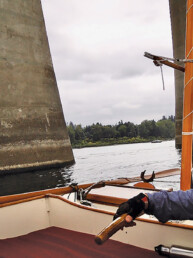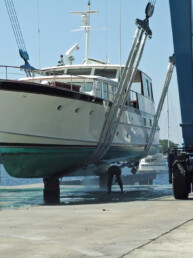I’ll just come right out and say it — I’m one of those weirdos who actually enjoys working on boat projects nearly as much as I enjoy being out on the boat.
Of all the upgrades and repairs we’ve made to our 1984 Passport 40 sailboat over the past decade, the latest one is among the best. It is something I’ve long dreamed of, but which seemed stubbornly out of reach. It is something that has made my boating life materially better and has already given me hours upon hours of pure pleasure. It is warm, comfortable, and wonderfully utilitarian. Sometimes I just stop, gaze around me, and sigh with contentment.
I call this wonderful addition “my garage.” Why? Because, well, it’s actually a garage.
No, not a boat garage, that place where you “stow” all the bits and pieces of cruising life. No, I mean the place with a big door, often attached to a home, where the boatless usually store their cars.
For those of us with boats, however, it can be the place where magic happens. Where pieces of broken equipment are brought back to life. Where wood is carefully cut, sanded and varnished. Where paint is painted, eyes spliced, canvas cleaned, holes drilled, and surfaces smoothed.
It’s a place where dreams are born, plans are hatched, and swear words can be delivered with a therapeutic and satisfying intensity.
Oh man, do I love my garage.
But it wasn’t always like this.
Seventeen years ago, I was living aboard my first boat, a lovely Islander Freeport 38 moored on Seattle’s Lake Union. While I had grown up sailing with my folks around Puget Sound, I was fairly new to boat ownership. And though I came from a family of DIYers — and consider myself fairly competent with tools and whatnot — I knew next to nothing about the inner workings of boats. Every system or part onboard seemed like a gigantic mystery bobbing in a sea of mortal peril.
If I remove this screw, will the boat sink? Will connecting this wire cause the engine to burst into flames?
I was a bit timid, to say the least. But over time my confidence in working on the boat began to grow — and along with it, my ambitions.
Soon I discovered that a lot of boat projects require making a big mess. They also often require pounding the bejesus out of something on a surface more robust than a teak table in the salon. Or they simply require more space than a floating chunk of fiberglass can provide.
I learned many valuable lessons during those years about how to create somewhat functional workspaces on the boat, lessons that have come in handy as we have extended the distances we cruise and the amount of time we spend aboard.
Then I got my first taste of a garage.
It was a single-car affair on the ground floor of a townhouse in Ballard. I remember being awestruck as that garage door lumbered upward the first time to reveal what seemed like an endless amount of workspace. Although the garage was empty, my mind quickly filled it with work benches, shelves, tables saws, and power tools.
The reality was that the space was about 10 feet wide and 20 feet long. And since this was city living, we actually had to park a car in there. Still, I made it work.
I installed a fold-down workbench on the port side of the garage and placed a hand-me-down wood cabinet to starboard. I built rough and ready shelves from floor to ceiling, carefully measuring them so they nestled around the front end of the car and still left an inch or two at the rear bumper so the garage door could shut.
It was so tight in there that you had to let your passenger out of the car before very slowly parking in the garage. And the driver had to hold their breath to squeeze out in the few inches of space left between the car door and the door leading inside the townhouse.
We grumbled all the time about that tight squeeze and the many other inconveniences that came with a dual-use space. But during those dark winter evenings, I would move the car out of the garage and transform it into my boat workshop. I spent many hours in there and got so many things done.
But as happens too often in life, what once seemed more than I could hope for eventually morphed over time into something that seemed like it could be so much better. Call it the land-based equivalent of two-foot-itis.
I began to dream of having enough space to set up a proper workbench and other workstations. I watched videos about building a real dust collection system and spent idle time reading reviews about drill presses and band saws that the little garage could never accommodate.
I needed to be realistic. Our plans are to go long-distance cruising, leaving our land-based lives behind for years. A good workshop would have to wait.
And then things changed again. Having a larger garage wasn’t the reason we eventually decided to move out of that townhouse. In fact, I was a great deal less than keen to go through the process of disrupting our lives, packing our belongings, and finding a new place to live. But move we did.
A few months back, for the second time in my adult life I stood in awe as a new, much larger garage door rattled upward to reveal what still feels to me like an embarrassment of workspace riches. This garage was big enough for two cars to sit comfortably side by side.
Not that we have actually parked a car in there. No indeed. Before we had even finished unpacking our boxes, I was busy making this garage into something truly comfortable. I finished out the drywall and painted the walls and ceiling. The concrete floor was prepped and coated with an epoxy paint to make it easier to keep spills from staining. And I began the process of installing workbenches and shelves. Heaven.
The space isn’t fully finished yet, not even close. There’s still no dust collection system or band saw. But all winter long, as our boat has sat on the hard in Anacortes undergoing the last major stage of an extensive refit, I’ve put this new garage to good use.
Stainless hardware that is normally permanently attached to the boat now sits in boxes waiting to be reinstalled after having been cleaned, repaired, and polished within an inch of its life. The steering pedestal has been torn down to just above the molecular level and rebuilt to better-than-new condition. Half of the boat’s bronze portholes have been dismantled, the fogged glass replaced with new, strong lenses and their metal restored to a golden shine. I’ll get started on the other half next week.
Lines, canvas, sails, and gear lay willy-nilly along one side of the garage, spending the winter warm and dry until they can be brought back to the boat. And in the middle of the garage, on a table built with a couple of sawhorses, the companionway hatch and hatch boards have been stripped, sanded, and varnished, just waiting for those final few coats of gloss.
When we do, finally, cut the dock lines and head out to fulfill the long-distance cruising dreams, I’m going to be back to where I started — garageless and finding ways to make a big mess in a small space on a floating hunk of fiberglass.
When that day comes, I know that I’m going to really miss this garage. Sure, it might look like a mess right now. But in just a few months, I’ve already filled it full of something else, something that doesn’t take up any physical space at all — a sense of pride in the work that I’ve accomplished and the boat problems I’ve solved in that warm, comfortable, and wonderfully utilitarian space.
Three Sheets Northwest is produced by Deborah Bach and Marty McOmber. You can find them sailing their Passport 40 around the Salish Sea and beyond.






